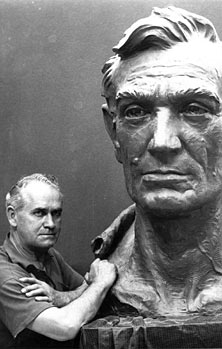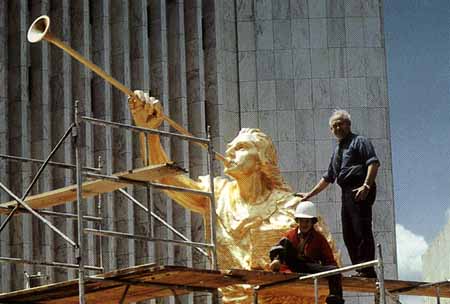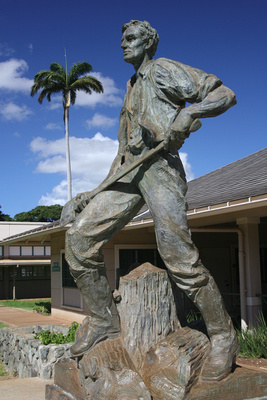Difference between revisions of "Avard Fairbanks: Mormon Artist"
(Created page with "300px|thumb|alt=Avard Fairbanks Mormon Artist|left [[[Avard Tennyson Fairbanks]]] was a prolific sculptor and art educator. He was a member of [...") |
|||
| (9 intermediate revisions by the same user not shown) | |||
| Line 1: | Line 1: | ||
[[Image:Avard_Fairbanks.jpg|300px|thumb|alt=Avard Fairbanks Mormon Artist|left]] | [[Image:Avard_Fairbanks.jpg|300px|thumb|alt=Avard Fairbanks Mormon Artist|left]] | ||
| − | + | '''Avard Tennyson Fairbanks''' was a prolific sculptor and art educator. He was a member of [http://Mormon.org The Church of Jesus Christ of Latter-day Saints]. | |
| − | Fairbanks was born on March 2, 1897, in Provo, Utah, to [[John | + | Fairbanks was born on March 2, 1897, in Provo, Utah, to [[John Fairbanks]] and Lilly A. Huish. His mother died about one year after his birth. His father and his oldest brother, J. Leo, who was a painter, instructed him in art in his childhood. Fairbanks sculpted ''A Rabbit in Clay'' when he was twelve years old and it won first prize at the 1909 Utah State Fair, but the judge refused to award him the medal, explaining that the contest was for professionals, not boys. |
| − | In | + | In 1910, his father was working at the Metropolitan Museum making private sale copies of the masterpieces. Avard Fairbanks was granted permission to copy some of the masterpieces. An article about him appeared in the New York Times (“Young Michaelangelo of this modern day in knickerbockers working at the Metropolitan Museum”) and when he was thirteen, he won a scholarship to the Art Students’ League in New York City where he studied under gifted sculptors, such as James Earl Fraser. After a year and a half in New York, he returned to Utah and yearned to study in Europe. He sculpted ''Buffalo'' when he was fifteen and hoped it would pay his way to France. His financing became available when a lion sculpture he did in butter for a creamery exhibit at the Utah State Fair led to commissions for work. At age seventeen, he was the youngest artist to be admitted to the École Nationale Supérieure des Beaux-Arts. He also studied at Academie Colarossi, École de La Grande Caumiere, and the Grand Salon in Paris. He and his father were forced to return to Utah in 1914 with the outbreak of World War I. |
| + | |||
| + | In Utah he finished high school and continued clay modeling. In 1915, he received his first major commission to work with his brother, J. Leo, sculpting the statuary and friezes on the [[Laie Hawaii Temple]]. While working in Hawaii, he met and married Maude Fox. When the temple sculptures were completed, they returned to Salt Lake City, where he started studying at the University of Utah. | ||
| − | |||
From 1920 to 1924, he taught sculpture at the University of Oregon. Fairbanks received his bachelor of fine arts degree from Yale University in 1925. He received a Guggenheim Fellowship to study in Rome and Florence, Italy. He then earned his master of fine art degree from the University of Washington and later a second master’s and a PhD in anatomy from the University of Michigan, where he was also a professor of sculpture. | From 1920 to 1924, he taught sculpture at the University of Oregon. Fairbanks received his bachelor of fine arts degree from Yale University in 1925. He received a Guggenheim Fellowship to study in Rome and Florence, Italy. He then earned his master of fine art degree from the University of Washington and later a second master’s and a PhD in anatomy from the University of Michigan, where he was also a professor of sculpture. | ||
In 1947, he was appointed dean of the University of Utah and tasked to create the College of Fine Arts. He retired from that post in 1955, but continued to teach for ten more years. | In 1947, he was appointed dean of the University of Utah and tasked to create the College of Fine Arts. He retired from that post in 1955, but continued to teach for ten more years. | ||
| − | Fairbanks created religious sculptures, small and large bronzes, marble carvings, medals, and relief panels. Among his most notable religious figures are the monuments honoring the Three Witnesses and commemorating the restoration of the Aaronic Priesthood; the bas reliefs on the base of the Nauvoo Bell Tower on Temple Square, the Tragedy of Winter Quarters at Florence, Nebraska. He created the Angel Moroni on the [[Jordan River Utah Temple]], the [[Seattle Washington Temple]], the [[Washington D.C. Temple]], and the [[Mexico City Mexico Temple]]. He also created a statue of Joseph Smith kneeling to receive the First Vision. | + | Fairbanks created religious sculptures, small and large bronzes, marble carvings, medals, and relief panels. Among his most notable religious figures are the monuments honoring the Three Witnesses and commemorating the restoration of the Aaronic [[Priesthood]]; the bas reliefs on the base of the Nauvoo Bell Tower on [[Temple Square]], the Tragedy of Winter Quarters at Florence, Nebraska. He created the Angel Moroni on the [[Jordan River Utah Temple]], the [[Seattle Washington Temple]], the [[Washington D.C. Temple]], and the [[Mexico City Mexico Temple]]. He also created a statue of [[Joseph Smith]] kneeling to receive the [[First Vision]]. |
[[Image:Fairbanks_Moroni_DC.jpg|300px|thumb|alt=Avard Fairbanks Mormon Artist|right|frame|]] | [[Image:Fairbanks_Moroni_DC.jpg|300px|thumb|alt=Avard Fairbanks Mormon Artist|right|frame|]] | ||
| − | He created hood ornaments for Chrysler Motor Company. He created the mermaid (Flying Lady) for the Plymouth Company and the ram for the Dodge Company. When management from Chrysler came to see the design, they asked Fairbanks what a ram had to do with Dodge. Fairbanks replied that when people see a ram coming down the road, they'll say “dodge!”[http://www.lib.utah.edu/collections/utah-artists/UAP-Avard-Fairbanks.php] | + | He created hood ornaments for Chrysler Motor Company. He created the mermaid (Flying Lady) for the Plymouth Company and the ram for the Dodge Company. When management from Chrysler came to see the design, they asked Fairbanks what a ram had to do with Dodge. Fairbanks replied that when people see a ram coming down the road, they'll say “dodge!”[http://www.lib.utah.edu/collections/utah-artists/UAP-Avard-Fairbanks.php] The idea evolved beyond that hood ornament and become an integral part of the Dodge logo. Fairbanks also created the griffin ornament for the 1933 Hudson Essex Terraplane. He sculpted a bust of Walter P. Chrysler and taught the Chrysler engineers how to use clay and sculpture techniques instead of wood and carpentry to create automobile designs. |
| + | |||
| + | At the end of World War I, he was commissioned to do a war memorial, Victorious American Doughboy, for the state of Idaho. This commission led to his teaching appointment at the University of Oregon and to numerous other commissions, including Ninety-first Division Monument, Ft. Lewis, Washington; a memorial to a Pioneer Family, on the Bismark, North Dakota, capitol grounds; a bust of Albert Woolson, one of the last survivors of the Civil War, overlooking the Gettysburg battlefield (a copy is in Duluth, Minnesota); and the Pony Express in bronze, in both Reno, Nevada, and Lake Tahoe, California. Four of his statues (more than any other sculptor) are housed in Statuary Hall, in the Washington, D.C. capitol building. and four different marble busts of Lincoln at different times in his life, displayed at the Ford’s Theater, where the president was assassinated. | ||
| − | |||
[[Image:Fairbanks_Lincoln.jpg|300px|thumb|alt=Avard Fairbanks Mormon Artist|right|frame|]] | [[Image:Fairbanks_Lincoln.jpg|300px|thumb|alt=Avard Fairbanks Mormon Artist|right|frame|]] | ||
| − | Fairbanks and his wife were the parents of eight sons. When in Sparta for the 1955 dedication of his sculpture, Lycurgus, the Law Giver, | + | |
| + | Fairbanks and his wife, Maude, were the parents of eight sons. Sons Grant, David, and Justin each contributed to the creation of the [[Eagle Gate Monument]] in downtown Salt Lake, near Temple Square. When in Sparta for the 1955 dedication of his sculpture, Lycurgus, the Law Giver, Fairbanks and his wife noticed two young girls who needed a home and asked to adopt them. He was later knighted by King Paul of Greece. | ||
Fairbanks died in Salt Lake City on January 1, 1987. | Fairbanks died in Salt Lake City on January 1, 1987. | ||
| + | |||
| + | * [http://www.ldsliving.com/The-Famous-Brand-Symbol-Sculpted-By-a-Mormon/s/80201?utm_source=ldsliving&utm_medium=email Fairbanks Creates Ram Logo] | ||
| + | * [https://www.ranker.com/list/mormon-artists/famous-mormons Mormon Artists List] | ||
[[Category:Mormon Life and Culture]] | [[Category:Mormon Life and Culture]] | ||
Revision as of 16:53, 30 June 2018
Avard Tennyson Fairbanks was a prolific sculptor and art educator. He was a member of The Church of Jesus Christ of Latter-day Saints.
Fairbanks was born on March 2, 1897, in Provo, Utah, to John Fairbanks and Lilly A. Huish. His mother died about one year after his birth. His father and his oldest brother, J. Leo, who was a painter, instructed him in art in his childhood. Fairbanks sculpted A Rabbit in Clay when he was twelve years old and it won first prize at the 1909 Utah State Fair, but the judge refused to award him the medal, explaining that the contest was for professionals, not boys.
In 1910, his father was working at the Metropolitan Museum making private sale copies of the masterpieces. Avard Fairbanks was granted permission to copy some of the masterpieces. An article about him appeared in the New York Times (“Young Michaelangelo of this modern day in knickerbockers working at the Metropolitan Museum”) and when he was thirteen, he won a scholarship to the Art Students’ League in New York City where he studied under gifted sculptors, such as James Earl Fraser. After a year and a half in New York, he returned to Utah and yearned to study in Europe. He sculpted Buffalo when he was fifteen and hoped it would pay his way to France. His financing became available when a lion sculpture he did in butter for a creamery exhibit at the Utah State Fair led to commissions for work. At age seventeen, he was the youngest artist to be admitted to the École Nationale Supérieure des Beaux-Arts. He also studied at Academie Colarossi, École de La Grande Caumiere, and the Grand Salon in Paris. He and his father were forced to return to Utah in 1914 with the outbreak of World War I.
In Utah he finished high school and continued clay modeling. In 1915, he received his first major commission to work with his brother, J. Leo, sculpting the statuary and friezes on the Laie Hawaii Temple. While working in Hawaii, he met and married Maude Fox. When the temple sculptures were completed, they returned to Salt Lake City, where he started studying at the University of Utah.
From 1920 to 1924, he taught sculpture at the University of Oregon. Fairbanks received his bachelor of fine arts degree from Yale University in 1925. He received a Guggenheim Fellowship to study in Rome and Florence, Italy. He then earned his master of fine art degree from the University of Washington and later a second master’s and a PhD in anatomy from the University of Michigan, where he was also a professor of sculpture.
In 1947, he was appointed dean of the University of Utah and tasked to create the College of Fine Arts. He retired from that post in 1955, but continued to teach for ten more years. Fairbanks created religious sculptures, small and large bronzes, marble carvings, medals, and relief panels. Among his most notable religious figures are the monuments honoring the Three Witnesses and commemorating the restoration of the Aaronic Priesthood; the bas reliefs on the base of the Nauvoo Bell Tower on Temple Square, the Tragedy of Winter Quarters at Florence, Nebraska. He created the Angel Moroni on the Jordan River Utah Temple, the Seattle Washington Temple, the Washington D.C. Temple, and the Mexico City Mexico Temple. He also created a statue of Joseph Smith kneeling to receive the First Vision.
He created hood ornaments for Chrysler Motor Company. He created the mermaid (Flying Lady) for the Plymouth Company and the ram for the Dodge Company. When management from Chrysler came to see the design, they asked Fairbanks what a ram had to do with Dodge. Fairbanks replied that when people see a ram coming down the road, they'll say “dodge!”[1] The idea evolved beyond that hood ornament and become an integral part of the Dodge logo. Fairbanks also created the griffin ornament for the 1933 Hudson Essex Terraplane. He sculpted a bust of Walter P. Chrysler and taught the Chrysler engineers how to use clay and sculpture techniques instead of wood and carpentry to create automobile designs.
At the end of World War I, he was commissioned to do a war memorial, Victorious American Doughboy, for the state of Idaho. This commission led to his teaching appointment at the University of Oregon and to numerous other commissions, including Ninety-first Division Monument, Ft. Lewis, Washington; a memorial to a Pioneer Family, on the Bismark, North Dakota, capitol grounds; a bust of Albert Woolson, one of the last survivors of the Civil War, overlooking the Gettysburg battlefield (a copy is in Duluth, Minnesota); and the Pony Express in bronze, in both Reno, Nevada, and Lake Tahoe, California. Four of his statues (more than any other sculptor) are housed in Statuary Hall, in the Washington, D.C. capitol building. and four different marble busts of Lincoln at different times in his life, displayed at the Ford’s Theater, where the president was assassinated.
Fairbanks and his wife, Maude, were the parents of eight sons. Sons Grant, David, and Justin each contributed to the creation of the Eagle Gate Monument in downtown Salt Lake, near Temple Square. When in Sparta for the 1955 dedication of his sculpture, Lycurgus, the Law Giver, Fairbanks and his wife noticed two young girls who needed a home and asked to adopt them. He was later knighted by King Paul of Greece.
Fairbanks died in Salt Lake City on January 1, 1987.


